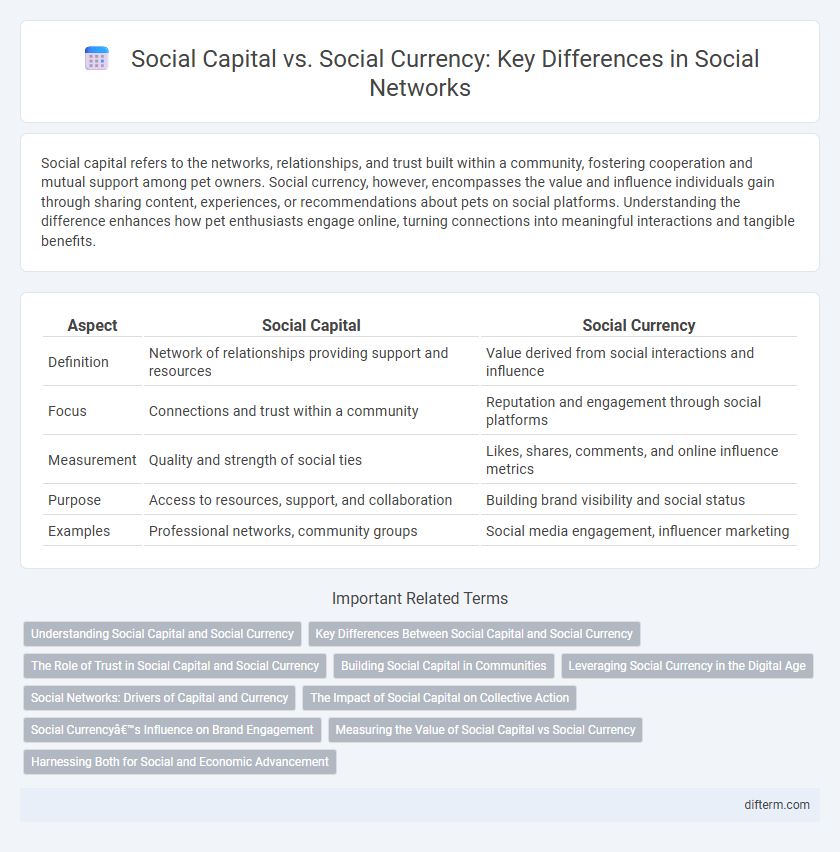Social capital refers to the networks, relationships, and trust built within a community, fostering cooperation and mutual support among pet owners. Social currency, however, encompasses the value and influence individuals gain through sharing content, experiences, or recommendations about pets on social platforms. Understanding the difference enhances how pet enthusiasts engage online, turning connections into meaningful interactions and tangible benefits.
Table of Comparison
| Aspect | Social Capital | Social Currency |
|---|---|---|
| Definition | Network of relationships providing support and resources | Value derived from social interactions and influence |
| Focus | Connections and trust within a community | Reputation and engagement through social platforms |
| Measurement | Quality and strength of social ties | Likes, shares, comments, and online influence metrics |
| Purpose | Access to resources, support, and collaboration | Building brand visibility and social status |
| Examples | Professional networks, community groups | Social media engagement, influencer marketing |
Understanding Social Capital and Social Currency
Social capital refers to the networks, relationships, and trust that enable collective action and resource exchange within communities. Social currency measures the value individuals or brands gain from their social interactions, influencing reputation and online engagement. Understanding the interplay between social capital and social currency helps organizations leverage trust and influence to enhance community participation and brand loyalty.
Key Differences Between Social Capital and Social Currency
Social capital refers to the networks, relationships, and trust that enable individuals or groups to access resources and support within a community. Social currency represents the value or influence one gains through meaningful interactions and engagement in social networks, often measured by likes, shares, or reputation. The key difference lies in social capital being the actual resource pool built over time, while social currency is the perceived value and leverage obtained through social interactions.
The Role of Trust in Social Capital and Social Currency
Trust serves as the foundational element of social capital, enabling networks of relationships to foster cooperation and collective action. In social currency, trust enhances the perceived value and credibility of exchanges, increasing social influence and engagement within communities. Both concepts rely on trust to build meaningful connections that drive social interactions and resource mobilization.
Building Social Capital in Communities
Building social capital in communities involves fostering trust, cooperation, and mutual support among members, which enhances collective resources and resilience. Social capital thrives through consistent interaction, shared norms, and networks that encourage collaboration, while social currency refers to the value generated from social interactions and reputation within these networks. Investing in local relationships and community engagement strengthens social capital, creating a foundation for sustainable social development and improved quality of life.
Leveraging Social Currency in the Digital Age
Leveraging social currency in the digital age enhances brand reputation and fosters community engagement by utilizing online interactions, shares, and endorsements as valuable assets. Social currency, driven by platforms like Instagram and TikTok, amplifies trust and influence more effectively than traditional social capital, which relies on offline networks and relationships. Brands that optimize user-generated content and digital advocacy convert social currency into measurable business outcomes such as increased loyalty and organic growth.
Social Networks: Drivers of Capital and Currency
Social networks function as pivotal drivers of both social capital and social currency by facilitating trust, reciprocity, and information exchange among individuals. Social capital emerges through the strength and diversity of interpersonal connections, enhancing cooperation and access to resources. Simultaneously, social currency leverages network influence and reputation to generate value, motivating engagement and social interaction within communities.
The Impact of Social Capital on Collective Action
Social capital strengthens trust, norms, and networks that enable groups to coordinate and cooperate effectively, driving successful collective action. High levels of social capital facilitate resource sharing, information flow, and mutual support, which are essential for mobilizing communities toward common goals. The depth and quality of social ties often determine the resilience and sustainability of collective endeavors in social movements and community development.
Social Currency’s Influence on Brand Engagement
Social currency drives brand engagement by leveraging consumers' emotional connections and social interactions, turning customers into active brand advocates. Unlike traditional social capital, social currency quantifies the value generated through user-generated content, shares, and online conversations that amplify brand visibility. Brands with high social currency experience increased loyalty and deeper engagement, as consumers feel rewarded and influential within their social networks.
Measuring the Value of Social Capital vs Social Currency
Measuring the value of social capital involves assessing relationships, trust, and network size to determine influence and resource accessibility within a community. Social currency metrics focus on online engagement, brand advocacy, and content sharing to quantify perceived social value and user-generated promotion. Both social capital and social currency are critical for understanding social dynamics, but while social capital emphasizes qualitative trust and relational depth, social currency prioritizes quantifiable digital interaction and brand perception.
Harnessing Both for Social and Economic Advancement
Harnessing social capital and social currency drives both social cohesion and economic growth by leveraging trust, networks, and reputation within communities and markets. Social capital creates collective value through relationships and shared norms, while social currency enhances individual influence and brand engagement in digital and offline spaces. Together, these assets enable innovative collaborations, increased access to resources, and sustainable development across societal and economic dimensions.
social capital vs social currency Infographic

 difterm.com
difterm.com